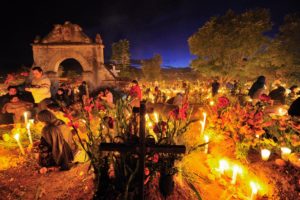
“The word death is not pronounced in New York, in Paris, in London, because it burns the lips. The Mexican, in contrast, is familiar with death… jokes about it, caresses it, sleeps with it, celebrates it. It is one of his favorite toys and his most steadfast love.” –Octavio Paz, Nobel Prize Winner in Literature
Full of riotous colors, effervescence and life-affirming joy, the film Coco teaches about Día de Muertos, Day of the Dead. For many pre-Hispanic cultures, death was believed to be a natural phase in life’s long continuum. The dead were still members of the community, kept alive in memory and spirit—and during Día de los Muertos, they temporarily returned to Earth. Families put up ofrendas (altars) in their homes and in cemeteries to welcome spirits back to the land of the living–they often include marigolds and other flowers, food, drinks, and music or toys that the family members enjoyed on earth. It’s a moment when the ethereal get to enjoy the essence of the earthly, and since they are coming home to visit, they are made to feel welcome. The family eats, sings and tells favorite stories about those who have died. This celebration of love and respect for deceased families members is being taught to children and adults through the colorful film, Coco.
A lovely member of our Unitarian Universalist congregation creates an altar for Día de Muertos every year. To the altar of flowers, candles, and pierced paper decorations, we add photographs of our family members and friends who have died. I treasure this ritual as a way of continuing to deal with the grief of loved ones; the grief never leaves me, but taking part in this beautiful remembrance is healing. There is much to learn from other cultures, and incorporating the rituals we find helpful is a way of dealing with our grief while honoring their traditions.

Flowers and candles set the mood during a Day of the Dead vigil at a cemetery in Oaxaca, Mexico.